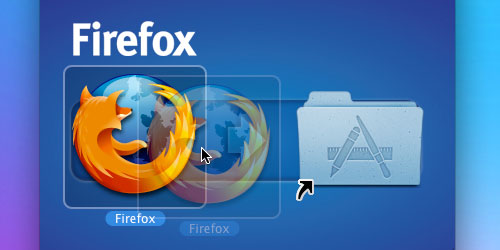Intuitive, and Not So Intuitive
Smashing Magazine has a “top ten” good-things article about the Mac, and #2 is intuitiveness. I couldn’t agree more, but the example they use–installing apps by drag-and-drop–brings to mind something which is somewhat less than intuitive about how that process often works, and I thought I might take a crack at explaining and hopefully simplifying it here.
If you’re a PC-to-Mac switcher, you may have noticed some difficulties in installing apps using files with the “.dmg” filename extension. It’s because how the “.dmg” (“disk image”) works can confuse people. Software developers will often use disk images as a way of conveying their software to users, so you’re bound to encounter them–like when you download Skype or Firefox.
Disk images are what the name implies: virtual images of a physical disk. Double-clicking on a .dmg file will cause a disk image to appear on your Mac, just as if you had plugged in a physical disk, like a USB flash memory stick, an external hard drive, or a data-DVD. Except that the virtual disk is not physically there–it’s just a representation of the data in the .dmg file.
What’s hard to visualize is that the .dmg file and that virtual disk image are the same thing–one of them (the virtual disk) being an accessible but temporary version of the other (the disk image).
A bit more confusing is the added step of copying the software from the virtual disk to your Applications folder. So, you downloaded the .dmg file, opened it up to show a virtual disk, and then copied the software from the virtual disk to your Applications folder on your hard drive. You can see how this gets a bit confusing.
After saving the application on your hard drive, you then have to close or “eject” the virtual disk, thereby “closing” the .dmg file. Then you can choose to store the .dmg file for later use, or (more likely) delete it from your disk by putting it in the trash.
After you get used to all of this, it becomes second nature, and just another level of metaphors to use. Before you get used to it, however, some difficulties can occur.
Problems arise when people take a different path to using new software presented in a .dmg file: instead of dropping the app into their Applications folder, they simply open the program on the virtual disk image and use it that way. And that works–most apps can operate from any location, even a virtual one. This is common when app developers make the stupid move of not including an Applications folder shortcut in the virtual disk with a cue for the user to copy the app there; since many virtual disks also disable the window sidebar which contains the usual shortcut to the Applications folder, it can be doubly discouraging to taking the correct action. So a lot of people will simply try to use the app directly from the disk image’s virtual disk.

The problem: when you eject the virtual disk (or just shut down your computer), the virtual disk, and the app, are no longer available, and users are left to wonder where their app disappeared to. (Answer: it’s tucked inside the .dmg file, and if you tossed that, then you tossed the app too–which is why you should have copied it to your Applications folder.)
Some users might drop the app into the Dock while the virtual disk is still open, and then eject the virtual disk–believing they have “copied” the app to their computer. Since the Dock icons are just shortcuts, the app is still not on a real, physical drive–even worse, when you try to open the app, it will react by re-opening the .dmg file automatically and loading the virtual disk again. If you erased the .dmg file, the Dock icon will become a question mark when you try to open it.
So just remember the simple process whenever you get a .dmg file: open the disk image, drop the app into your Application folder, then close/eject the image and then archive/erase the .dmg file. Then use the app you copied into your Applications folder.
Okay, it’s not a “simple” process until you get used to it. But it’s a process you should be aware of. Hope this explanation helps.
